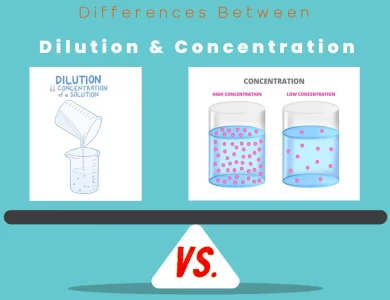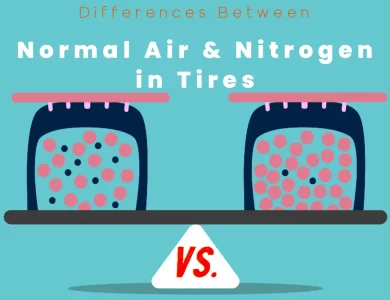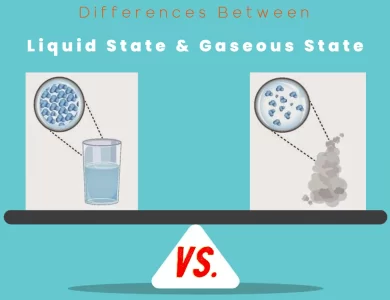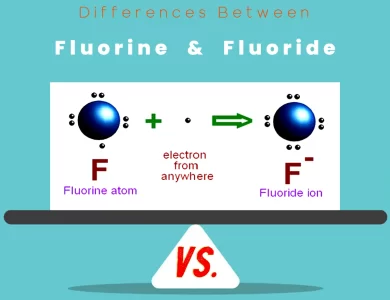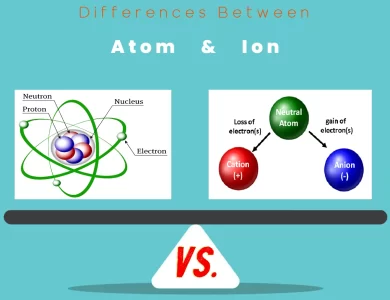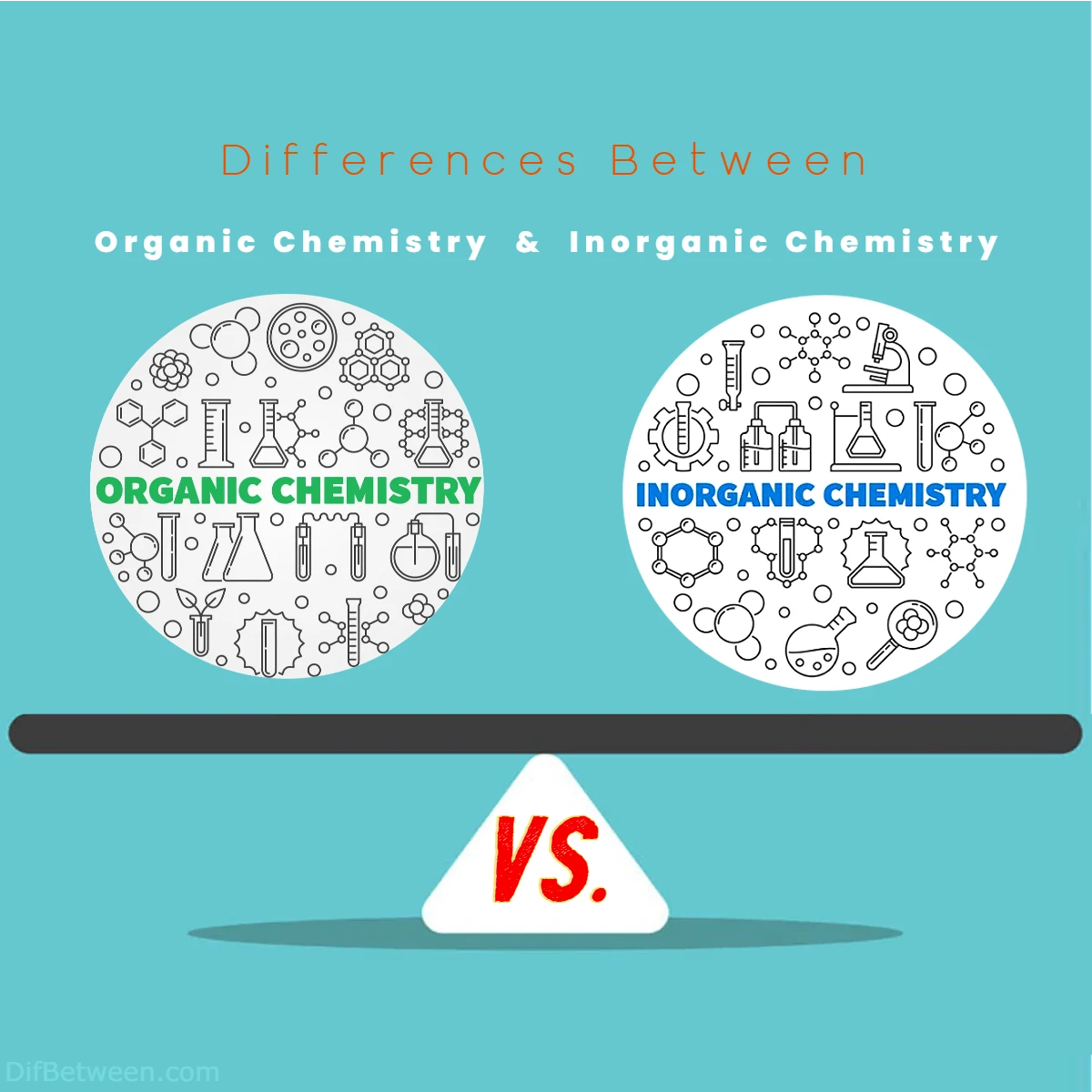
| Aspect | Organic Chemistry | Inorganic Chemistry |
|---|---|---|
| Scope | Focuses on carbon compounds and their reactions. | Encompasses compounds beyond carbon, including metals, minerals, and more. |
| Bonding | Primarily covalent bonding between carbon and other elements. | Involves covalent and ionic bonding, as well as coordination bonding with metal atoms. |
| Functional Groups | Involves diverse functional groups that dictate reactivity. | Focuses on coordination complexes and ligand interactions. |
| Reactivity | Complex reaction mechanisms and functional group transformations. | Involves coordination rearrangements, ligand exchanges, and redox processes. |
| Applications | Impacts pharmaceuticals, plastics, food, textiles, and more. | Influences catalysis, electronics, materials, and industrial processes. |
| Emphasis | Carbon-centered complexity and synthesis of new organic molecules. | Exploration of metallic properties, color changes, and complex coordination structures. |
| Field Overlaps | Collaborates with biochemistry and medicinal chemistry. | Integrates with bioinorganic chemistry, materials science, and nanotechnology. |
| Education Emphasis | Reaction mechanisms, functional group reactivity, and synthesis. | Coordination chemistry, transition metal properties, and electronic structure. |
| Career Opportunities | Drug discovery, materials science, organic synthesis, and more. | Catalysis research, materials design, industrial processes, and academia. |
| Examples | Carbohydrates, proteins, organic synthesis. | Transition metal complexes, catalysts, minerals. |
| Laboratory Focus | Synthesis, functional group tests, spectroscopy. | Coordination chemistry, ligand exchange, spectroscopy. |
Organic chemistry, the realm of carbon compounds and the building blocks of life itself, beckons us with its symphony of functional groups, intricate reactions, and the promise of crafting molecules that change the world. Meanwhile, inorganic chemistry takes us beyond carbon’s embrace, unlocking the mysteries of metals, minerals, and the stunning transformations that occur in the realm of metal-driven reactivity. From the hues of transition metal complexes to the intricacies of ligand coordination, every corner of these domains holds a world of fascination waiting to be explored.
Differences Between Organic Chemistry and Inorganic Chemistry
Organic Chemistry and Inorganic Chemistry differ fundamentally in their focus and scope. Organic Chemistry revolves around carbon compounds, exploring their diverse structures and intricate reactions, often found in living organisms. In contrast, Inorganic Chemistry encompasses compounds beyond carbon, delving into metals, minerals, and their unique properties. While Organic Chemistry primarily involves covalent bonds and functional groups, Inorganic Chemistry encompasses both covalent and ionic bonds, with a focus on coordination bonding with metal atoms. These differences extend to reactivity, applications, and even career paths, making Organic and Inorganic Chemistry distinct yet interconnected realms within the vast landscape of chemistry.
Defining the Boundaries
At the heart of the matter lies the distinction between organic and inorganic chemistry – a distinction that goes beyond the compounds themselves and delves into their very essence.
Organic Chemistry: Carbon’s Delight
Organic chemistry is often synonymous with the study of carbon compounds, and rightfully so. Carbon, the chameleon of the periodic table, can form a staggering array of molecules by bonding with itself and other elements like hydrogen, oxygen, nitrogen, sulfur, and more. These compounds, commonly found in living organisms, are the building blocks of life itself. Organic chemistry encompasses everything from the carbohydrates that fuel our bodies to the proteins that structure them.
The unique versatility of carbon lies in its ability to form long chains, branched structures, and intricate rings – a symphony of shapes that creates the vast diversity of organic molecules. This complexity gives rise to the intricate world of functional groups – specific arrangements of atoms that dictate a molecule’s behavior in reactions. Think of it as the molecular language that organic chemists decipher to predict how compounds will interact.
Inorganic Chemistry: Beyond Carbon’s Realm
In contrast, inorganic chemistry embraces the elements beyond carbon’s cozy domain. It encompasses compounds that don’t necessarily fall under the organic umbrella, such as metals, minerals, and noble gases. While organic chemistry often revolves around the interactions of carbon, hydrogen, and a few other elements, inorganic chemistry steps into a broader arena where the rules of bonding and reactivity can differ significantly.
Inorganic compounds can exhibit an astonishing array of colors, magnetic properties, and catalytic behaviors. Just think of the vibrant hues of transition metal complexes or the incredible utility of catalysts in industrial processes. Inorganic chemistry unravels the mysteries of these compounds, exploring their structures, properties, and applications.
Bonding: The Great Connector
The very nature of chemical bonding varies between organic and inorganic compounds, giving rise to distinct behaviors and characteristics.
Organic Bonding: Covalent Connections
Organic compounds are primarily bound together through covalent bonds, where atoms share electrons to achieve stability. These bonds can vary in strength, and the manner in which atoms are connected can significantly influence a molecule’s reactivity and properties. Functional groups, those recurring arrangements of atoms, define how a molecule interacts with its surroundings. Organic chemists carefully study these groups to predict how a compound will behave in various reactions.
Inorganic Bonding: Diverse Possibilities
In the realm of inorganic chemistry, the bonding landscape is far more diverse. While covalent bonds still play a crucial role, ionic bonds – where electrons are transferred from one atom to another – are prevalent in inorganic compounds. This distinction leads to differences in solubility, melting points, and electrical conductivity between organic and inorganic substances. Moreover, the phenomenon of coordination bonding takes center stage in inorganic chemistry, where central metal atoms are surrounded by a coordinated array of other atoms or molecules. This gives rise to complex structures seen in transition metal coordination complexes and other inorganic compounds.
Reactivity: Dance of the Molecules
The way molecules react and transform is the heartbeat of chemistry. Organic and inorganic reactions follow different rhythms, contributing to their unique identities.
Organic Reactivity: Delicate Symphony
Organic reactions often involve breaking and forming covalent bonds. The intricacies lie in the functional groups and the specific conditions that promote or hinder these transformations. Organic chemistry is notorious for its vast array of reaction mechanisms, where electrons shift, bonds break, and new bonds form. Understanding these mechanisms is like deciphering a complex musical composition – it requires careful observation and interpretation.
Inorganic Reactivity: Coordination Complexity
In the world of inorganic chemistry, reactions frequently revolve around the rearrangement of coordination complexes. Ligands – molecules or ions that can donate electron pairs – bind to central metal atoms, and these interactions dictate the compound’s behavior. Inorganic reactions can involve ligand exchange, redox processes, and various other mechanisms that lead to changes in coordination geometry or oxidation state. The result? A rich tapestry of reactivity that drives the synthesis of inorganic compounds with diverse applications.
Applications: From Lab to Life
Both organic and inorganic chemistry contribute significantly to our daily lives, albeit in different ways. Let’s explore the practical applications that stem from each branch.
Organic Applications: Life’s Essentials
Organic chemistry’s influence permeates our existence. The pharmaceutical industry relies on organic synthesis to create life-saving drugs, using reactions that selectively modify specific functional groups. The food we consume, the clothes we wear, and the plastics that fill our world – all are products of organic chemistry. Even the dyes that give color to fabrics and the pigments used in art find their origins in the intricate world of organic compounds.
Inorganic Applications: Catalysts and Beyond
Inorganic chemistry, on the other hand, plays a vital role in catalysis – the acceleration of chemical reactions. Many industrial processes, from petroleum refining to the production of fertilizers, rely on inorganic catalysts. The development of materials with specific electronic, optical, or magnetic properties also falls within the realm of inorganic chemistry. Consider the phosphors that light up screens or the superconductors that revolutionize energy transmission – both owe their existence to the insights of inorganic chemists.
Beyond the Laboratory: Organic and Inorganic Chemistry in Everyday Life
As we delve deeper into the realm of chemistry, it’s intriguing to uncover the ways in which organic and inorganic compounds influence our daily lives, sometimes in ways we might not even realize.
Organic Chemistry: From Plate to Palate
Organic chemistry’s impact on our culinary experiences is profound. Consider the delectable world of flavors and aromas found in fruits, spices, and herbs. The compounds responsible for these sensory delights are often complex organic molecules. Even the act of cooking itself is a symphony of organic reactions – the caramelization of sugars, the Maillard reaction that gives roasted coffee its flavor, and the breakdown of fatty acids that tantalize our taste buds. Organic chemistry also plays a significant role in food preservation, ensuring that our meals remain safe and appetizing on their journey from farm to table.
Inorganic Chemistry: Colors of the World
The vibrant colors that adorn our surroundings owe much of their brilliance to inorganic compounds. Transition metal ions, with their unique electron configurations, exhibit a mesmerizing array of colors when they absorb and emit light. From the deep blue of copper sulfate to the rich red of iron oxide, these compounds have found their way into pigments for paints, dyes, and even stained glass windows. Inorganic chemistry’s exploration of these compounds’ properties allows artists and designers to infuse their creations with a kaleidoscope of hues that evoke emotions and tell stories.
Innovations: Pushing the Boundaries of Possibility
In the ever-evolving landscape of science and technology, both organic and inorganic chemistry continue to shape the trajectory of innovation, often collaborating to achieve remarkable feats.
Organic Innovations: Materials of Tomorrow
Organic electronics have emerged as a promising field, where carbon-based molecules and polymers exhibit semiconducting properties. Organic light-emitting diodes (OLEDs) are a prime example, revolutionizing display technology with their energy efficiency and flexibility. Organic photovoltaics (OPVs) aim to harness solar energy through lightweight and cost-effective materials. Additionally, organic chemistry’s role in developing biodegradable plastics and sustainable materials addresses the pressing environmental challenges of our time.
Inorganic Innovations: Advancing Industries
Inorganic chemistry’s impact reverberates throughout industries critical to modern life. The catalytic converters in our cars, which reduce harmful emissions, rely on transition metal catalysts. The production of ammonia-based fertilizers, crucial for global agriculture, hinges on inorganic reactions. Moreover, advancements in nanotechnology, where materials are engineered at the nanoscale, often involve inorganic compounds. These innovations pave the way for breakthroughs in medicine, electronics, and environmental remediation.
Education and Exploration: Unveiling the Unknown
The study of both organic and inorganic chemistry offers aspiring scientists the opportunity to unlock the mysteries of the microscopic world, foster critical thinking, and contribute to the advancement of human knowledge.
Organic Education: From Textbooks to Test Tubes
Organic chemistry is often a rite of passage for chemistry students, challenging them to grasp intricate reaction mechanisms and functional group transformations. Laboratories become playgrounds of exploration, where students synthesize and analyze organic compounds, honing their practical skills and understanding the nuances of chemical reactions. Organic chemistry’s emphasis on pattern recognition and deductive reasoning equips learners with problem-solving tools applicable across scientific disciplines.
Inorganic Education: Complex Discoveries
Inorganic chemistry’s education landscape is equally captivating. Students grapple with coordination chemistry, molecular orbital theory, and crystallography to unravel the complexities of inorganic compounds. Hands-on experiences with spectroscopic techniques and computational tools allow them to delve into the electronic and geometric intricacies of molecules. Aspiring inorganic chemists contribute to diverse fields, from unraveling the mechanisms of enzyme activity to designing new catalysts for sustainable energy production.
Collaborative Frontiers: The Future Beckons
As we peer into the horizon of scientific discovery, it’s clear that the boundaries between organic and inorganic chemistry will continue to blur. Collaborative efforts between these branches yield astonishing insights and applications that drive progress in myriad fields.
Emerging Fields: Supramolecular Chemistry
Supramolecular chemistry bridges the gap between organic and inorganic realms, focusing on the interactions between molecules that result in complex structures. Think of it as chemistry’s version of architectural design at the nanoscale. Researchers in this field engineer molecules to self-assemble into functional materials with applications ranging from drug delivery to nanoelectronics. By understanding how molecules communicate and cooperate, supramolecular chemists forge new frontiers of possibility.
Bioinorganic Chemistry: Nature’s Coordinated Dance
Bioinorganic chemistry merges inorganic concepts with the biochemical intricacies of living organisms. It investigates the roles of metal ions in biological systems, revealing how metals participate in enzymatic reactions, oxygen transport, and even DNA replication. This field underscores the interplay between organic molecules and metal ions in driving essential life processes, proving that the boundary between organic and inorganic is not insurmountable.
Organic Chemistry or Inorganic Chemistry: Which One is Right Choose for You?
The Organic Odyssey:
For the Curious Creators: If you’re drawn to the intricate dance of molecules and have a knack for deciphering complex patterns, organic chemistry might be your calling. The world of carbon compounds, functional groups, and reaction mechanisms awaits your curiosity. You’ll be the alchemist, crafting new molecules with unique properties that can change the course of industries and even save lives through innovative drugs.
Passion for the Practical: Organic chemistry has tangible applications that touch our everyday lives. From the flavors in your favorite foods to the clothes you wear, the principles you’ll uncover in organic chemistry are woven into the fabric of existence. If you’re excited about seeing your theoretical insights translate into real-world products, organic chemistry is your gateway.
The Analytical Artisan: Organic chemists often spend quality time in the laboratory, transforming ideas into reality. If you find solace in the controlled chaos of the lab, where precise measurements and meticulous techniques rule, organic chemistry’s experimental side will be your realm of expertise.
The Inorganic Insight:
Metal Minds Unleashed: For those who gaze upon the periodic table and are intrigued by the metals’ magnetic allure, inorganic chemistry beckons. Transition metal complexes, catalysts, and compounds with intriguing electronic properties will become your playground. If the thought of unlocking the secrets of color-changing compounds ignites your curiosity, you’re on the right path.
The Catalyst for Change: Inorganic chemistry has a knack for innovation. If you’re captivated by the idea of developing catalysts that can drive crucial industrial processes, or if the concept of manipulating materials at the nanoscale resonates with you, inorganic chemistry’s applications in energy, materials, and beyond will be your passion.
The Theoretical Voyager: While inorganic chemistry does involve practical experimentation, it also beckons theoretical thinkers. Delve into molecular orbital theory, ligand field theory, and crystallography to uncover the deep-seated principles that dictate the behaviors of inorganic compounds. If you’re more comfortable with equations and calculations than with test tubes, this might be your intellectual playground.
A Hybrid Harmony: Organometallic Chemistry
Ah, but what if the lines between organic and inorganic chemistry blur for you? Fear not – there’s a bridge. Organometallic chemistry stands at the crossroads, offering a realm where organic molecules cozy up to metal atoms. If the idea of marrying the complexity of organic reactions with the intrigue of metal-driven properties entices you, consider venturing into this multidisciplinary field.
The Decision: Yours to Make
So, my curious friend, as you ponder the choice between organic and inorganic chemistry, remember that both paths hold their allure, challenges, and opportunities. Whether you’re crafting life-altering drugs as an organic virtuoso, harnessing the power of metals in inorganic marvels, or embracing the symbiosis of organometallics, your journey through the molecular realm will be a rewarding one.
FAQs
Organic Chemistry centers on carbon compounds, exploring their structures and reactions, often found in living organisms. Inorganic Chemistry, on the other hand, goes beyond carbon to study compounds such as metals, minerals, and their properties.
Organic Chemistry primarily involves covalent bonding, where atoms share electrons. Inorganic Chemistry includes both covalent and ionic bonding, with coordination bonding playing a key role, often involving metal atoms.
Functional groups are specific arrangements of atoms that dictate a molecule’s behavior. Organic Chemistry focuses on a wide variety of functional groups, while Inorganic Chemistry emphasizes ligand coordination and complex arrangements.
Organic Chemistry deals with complex reaction mechanisms involving carbon compounds and functional groups. Inorganic Chemistry involves reactions like ligand exchanges, coordination rearrangements, and redox processes in metal complexes.
Organic Chemistry impacts industries like pharmaceuticals, food, textiles, and plastics. Inorganic Chemistry finds applications in catalysis, materials science, electronics, and even the development of catalysts for industrial processes.
Yes, career paths can differ. Organic Chemists might focus on drug discovery, synthesis, and related fields. Inorganic Chemists might delve into catalysis, materials design, and industries requiring metal-driven reactions.
There’s an intersection known as organometallic chemistry, which merges organic molecules with metal atoms. This field combines the complexities of organic reactions with the intriguing properties of metals.
Organic Chemistry education emphasizes reaction mechanisms, synthesis, and functional group transformations. Inorganic Chemistry education covers coordination chemistry, transition metal properties, and electronic structure.
Organic Chemistry includes carbohydrates, proteins, and synthetic molecules. Inorganic Chemistry includes transition metal complexes, catalysts, and various minerals.
Absolutely! Organic Chemistry focuses on carbon compounds, covalent bonding, functional groups, and intricate reactions, often with applications in pharmaceuticals and materials. Inorganic Chemistry extends beyond carbon to include metals, ionic and covalent bonding, coordination complexes, and applications in catalysis, electronics, and more.
Read More:
Contents
- Differences Between Organic Chemistry and Inorganic Chemistry
- Defining the Boundaries
- Bonding: The Great Connector
- Reactivity: Dance of the Molecules
- Applications: From Lab to Life
- Beyond the Laboratory: Organic and Inorganic Chemistry in Everyday Life
- Innovations: Pushing the Boundaries of Possibility
- Education and Exploration: Unveiling the Unknown
- Collaborative Frontiers: The Future Beckons
- Organic Chemistry or Inorganic Chemistry: Which One is Right Choose for You?
- FAQs
